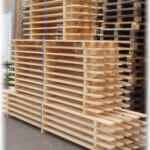Wooden pallets
They are the most common choice for transport, protection, storage, and manipulation with goods. There is available a wide range of different pallets according to the way of use. When choosing the correct pallet type, it is necessary to consider dimensions, load capacity, manipulation way, if the heat treatment is required by the state concerned, and possibly other quality parameters, eg. angularity, wanes, quality, etc. And, most importantly, what purpose and what goods the pallet is intended for. The main material is wood. As an auxiliary material can be used eg. foil or metal. The wooden pallets are more affordable than eg. plastic pallets and they are easier to recyclate.
Standard pallets
These are pallets with dimensions 1200x800mm. These pallets can be picked up from four sides, they are so-called four-way pallets.
Among the most common pallets with the load capacity of 1500kg (if the load is evenly spread on the pallet’s surface) belong EUR pallets, that can be used repeatedly. Production of these pallets is standardized. The lump woods are marked with a EUR protection stamp and in the Czech Republic, they are marked by the Czech guarantor, Czech railways – ČD as well. Furthermore, there may be seen markings as eg. DB, EPAL etc.
Other standard pallets are without registered marks.
Here belongs the non-marked EUR pallet. It’s dimensions correspond with the licensed version. It doesn’t have to have cut corners and milled-out boards.
Another variation is the so-called lightweight Euro pallet. This pallet has 5 equal boards (usually 80 mm wide) on the load-area and lump woods dimensions are mostly 80x80x80mm.
Pallets for atypical goods
Atypical pallets are produced based on the customer’s wish and requirements. The customer can choose for the pallet his own specific dimensions, spacing and number of boards for the load-area, used fasteners – nails and screws, wood type, load capacity, chamfering of the edges by cutting. For production, we usually use 18 – 22 mm thick boards. The dimension of the pallet can vary from a few hundreds millimetres to a few meters. It can be pallets with the load-area made of boards or baulks. Here belongs also eg. UK pallet, four-way pallet (the pallet can be picked up from four sides), two-way pallet, pallet with full load-area filled with boards or eg. oriented strand board, etc.
If you do not have your own technical drawing, or need a piece of advice regarding a pallet, let us know your requirements, we will find a suitable solution together.
Brick pallets
This kind of pallets is used especially in building industry for heavy materials, e.g. bricks, cement-tile pavement, etc. This pallet can be manipulated only from two sides, because it is not using the lump woods but baulks. It is a so-called two-way pallet. These pallets guarantee high load capacity, durability and long life thanks to their simple construction. The boards can be sharp-edged or with wane in the falling width. Again, the exact design only depends on the customer’s demands. In this group is involved also a US pallet (USA pallet), which too uses the baulks, but thanks to milled out openings can be manipulated from four sides.
Pallets’ wear
When manipulating with the pallets, they wear. According to the amount of the wear they are divided into several groups.
1) new pallets
2) Selection pallets marked as VB
At this state, the pallet does not have any marks of wear, is undamaged, used maximally once. It was manipulated very carefully and only in a clean environment.
3) A-type pallets (light-coloured)
The pallet bears marks of partial wear and even if it is multiple used, it’s colour is still light. It was manipulated in a clean environment and does not bear any marks of damage or repairs.
4) B-type pallets (dark-coloured)
The pallet bears marks of strong wear, the wood is dark, but it has to be fully operational and undamaged. In this category belong also pallets, that are repaired so that they fully comply with the UIC 435-2 direction, given that it is the EUR type of pallet. In case of a simple pallet, where the repair is not stated in the direction, it is enough, if the pallet is fully operational.
5) Pallets to be repaired
It is going on pallets, that do not comply with the direction, are not operational, or further manipulation with them endangers goods or its package and is inconsistent with the safety work criteria. The pallet needs repair when a stringer (lateral board), or any of the blanks of load- or supporting area, is missing or broken, or any of the blanks is rived in the horizontal axis so that it reveals one or more nails. The same applies to the lump-woods of pallets. If they are missing or disturbed, the pallet loses its cohesion.
The pallet is evaluated as non-repairable – determined to disposal, if one of three stringers in load-area is missing, obliquely or laterally broken. Another damage is evaluated as repairable.
These criteria apply mostly to EUR type pallets.
However, they can be applied to other pallet types as well.
Do you need help with choosing the right pallet? Contact us.
We will find a suitable solution together.




















